Magic Moments in a Mixed Ability Classroom
Despina Karamitsou, Greece
Despina Karamitsou is a teacher at Greek state schools. She is interested in artful teaching and has won the first prize for her work introducing Lapbooks and Dioramas in the English classroom at the 1st Hellenic Conference on Early Language Learning. She is interested in finding ways to inspire her students and help them learn not just the English language and culture but also life skills and values. E-mail: despinalina@yahoo.com

Menu
Introduction
Lead-ins
The Secret Door foldable card
Teaching outdoors
Conclusion
A classroom is a place filled with learners that have mixed abilities and talents. Creating Magic Moments where all students are interested and learning takes place unhindered is one of the most important goals of an educator. This article explores a few ways of «enchanting» language learners and helping them develop their abilities.
The first minutes of every lesson are the most important because they can develop a learning atmosphere. Learning starts with wonder, so surprising students can trigger their curiosity and enhance their attention.
- Enter the classroom waving an envelope and they will be eager to know what the letter is about. Come in, holding a box or a bag filled with objects and you will make the students wonder what is about to follow. Speaking takes place almost automatically as they form questions in an effort to guess the contents.
- Get dressed as a witch or a wizard, holding a broom and pretend that you have lost the Book of Spells on the way to school. Ask for their help in writing new spells and recipes for potions. This kind of introduction will make even the most reluctant learners work hard on difficult days such as the last day of the term or Halloween day. They will produce amazing writings and interesting vocabulary items will emerge (Platypus’ saliva, armpit sweat, flamingo’s feathers¸ frogs’ eyeballs-to name just a few.)
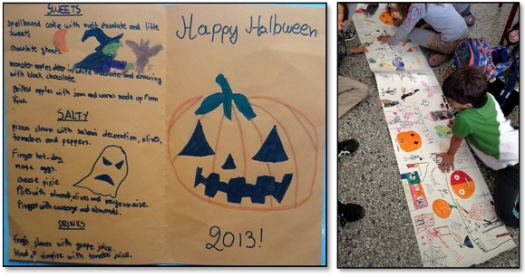
- Bringing food in the classroom can be a fun and tasty way to start a lesson and teach all about cooking verbs, ingredients, healthy and unhealthy food choices, meals of the day, utensils, restaurants...The list is endless.
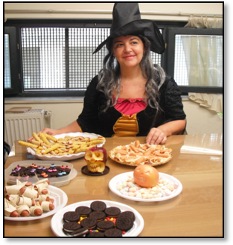
- Enter the classroom in a serious manner and announce that some money has been stolen from your handbag and accuse them of being suspects and you will have them asking questions wide eyed. Once you have grabbed their attention you can reveal their task. They all have to make false Identity Cards and play a «whodunit» game.
Integrating the Arts into language teaching enhances the learning experience. The Arts help right brained students shine. They foster creativity and collaboration between students. Last but not least, they create a fun, memorable language experience.
The Secret Door foldable card is an artful activity that can be used with any topic and any level. You can try them with:
- Questions and Answers
- Riddles and Mysteries
- Problems and advice
- Vocabulary definitions
- Grammar transformations (active-passive voice/used to/ too-enough/reported speech)
- Recipes (ingredients-instructions)
- Story books (who is who, sequence of events)
- Non-fiction texts (questions and answers)
- Cartoon captions
- Travel info (countries-nationalities-capitals-sights etc)
- Weather predictions
- Continue the story (or What happened before...)
- Animals (habitat, abilities, nutrition etc)
These are the instructions on how you can make Secret Doors:
You will need one A4 and a half pieces of coloured card paper.
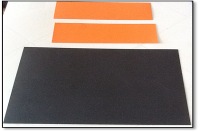
Fold the A4 sheet in half hamburger style.
Now that you have the midpoint line, fold each side in to meet that point.
Make 2, 3 or more even cuts from the middle of the paper to the creased middle of each side.
Take your half sheet of card paper and cut it in half-hotdog style.
Now use one of the quarter sheets you just cut, weaving it into the full sheet of card paper (where you created the slits).
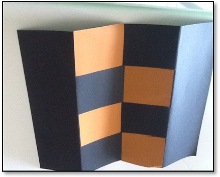
Weave the other quarter sheet into the full sheet on the opposite side but weave in the opposite direction of the first weave (under-over, over-under).
After you've finished weaving, flatten your sheet and fold it so it creates two doors!
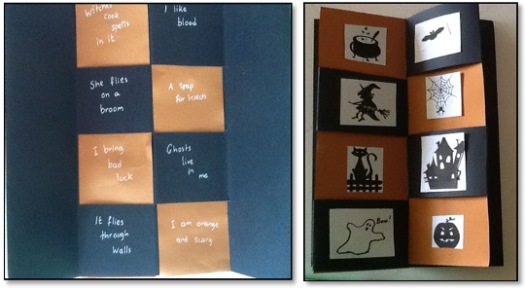
Open the first door and read the riddles, then, pull apart the middle line to reveal the secret door and the answers in pictures! Your students will be trully enchanted!
There is also an extremely useful YouTube video showing you how.
www.youtube.com/watch?v=X6vvv_HhYfs
- Have a readathon day! Ask students to bring beach towels for the lesson. This alone will create great anticipation. Go out in the park, if there is one near the school, or stay in the schoolyard and lie on the towels under the trees.
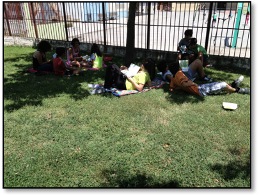
Bring a selection of books from the school’s library and let students choose to read whatever they like. DO NOT make them write reports. This is supposed to be just for fun and to teach them that reading is a pleasurable activity that can be done anywhere. If they don’t like what they read they can pick something else.
- Go on a Scavenger Hunt! On a sunny day or on the last day of school, surprise the students by organising a scavenger hunt in the schoolyard. Learning can take place out of the classroom and it can be pleasurable and efficient. Before the lesson starts, hide several objects in the schoolyard. Form teams and distribute handouts with clues such as:
- Something that bounces
- A seed
- Something beautiful
- A stone
- Something that makes noise
- Something soft
- Something hard
- Something round
- An old key
- An old CD
- A piece of paper
- A pencil
- A rubber
- A sea shell
- Something smelly
- Something sticky
- Something wet
- A name for your group
- Something yellow
- Something that is non-living
- Something that smells nice
- A ladybird
- An ant
- A piece of plastic
- Something that floats
- A piece of ribbon
- An small toy
- Something interesting
- Something lost
- Something shiny
- Something colourful
- Something strange
The hunt develops student’s critical thinking and collaboration. Some objects may fit more than one category so students have to decide where to register each object. You can also describe the items using riddles if the level is advanced. The team which finds the most objects is the winner.
Don’t just teach! Enchant your students, surprise them with interesting and creative activities and magic moments will multiply.

Please check the Methodology & Language for Primary Teachers course at Pilgrims website.
Please check the Creative Methodology for the Classroom course at Pilgrims website.


|